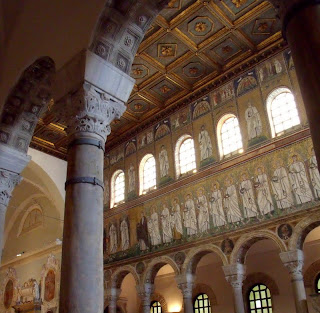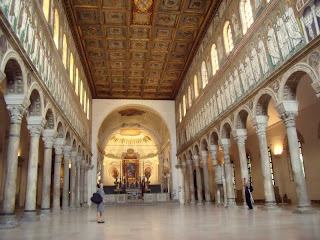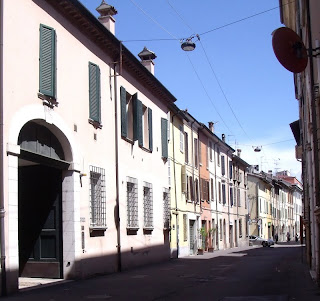It acted like a sorbet for the head, clearing it and in a way preparing us for what was to come.
Most of what we see is 4th and 5th century and remarkable it has survived as it has. Much of the wealth of the city in terms of anything removeable was plundered by goths or French popes. I did not hear a mention of that arch-thief Napoleon. I concluded therefore that everything that could be prised off walls was already long gone before he got to his pillaging phase.
As you move from church to church you see how later artists attempted to leave their own thumbprints along side the retained areas of mosaic. In no way is any of it successful. I don’t think even one distinguished painter provided a single fresco inRavenna
As you move from church to church you see how later artists attempted to leave their own thumbprints along side the retained areas of mosaic. In no way is any of it successful. I don’t think even one distinguished painter provided a single fresco in
The detail, colour, and proximity of abstract patterns form a bright, silent fairground. A kaleidoscope of colour, busyness and seeming movement; yet it is illusion: as all is still, and if you are lucky and there are few visitors about, quiet.
We were lucky. The streets were empty and so were the churches. We even had Theodora and Justinian all to ourselves apart from their accompanying static courtiers. They stare hieratically across the apse at one another, men on one side, women on the other, a stately procession towards the high altar. To enjoy all of this display you need both silence and sunlight. Although not the sunniest of days we did have stretches of strong light and it brought the work to life and allowed us to see the detail.
My photographs don’t much please me. I could do with a more powerful lens and a steadier hand. I don’t use flash, so there is a lot I could not successfully capture. But if you click onto the images you will get a small idea of the richness and beauty of these buildings.
These photographs are in sequence as we walked through the town to the handful of buildings we wanted to see. This first one, St Apollinare Nuovo, came after the bombed out church.
The tomb of Dante sits outside of the church of St Francis. Our useless guide book, note....don't buy those short Insight Guides, was so badly written that it gave the impression that the tomb sits inside the church. Entering through a side door I scoured the interior, ignoring anything else of interest, in my attempt to find the tomb. Giving up we left through the front door and then noticed the little mausoleum which oddly, was the only busy spot in the city. Here we were jostled by a very large group of Italians all of whom wanted photos of themselves in front of the tomb....but with no pesky furriners in the way. We were very directly told to move out of shot. I was not quick to oblige and wondered how many of these people had opened any Dante since their long gone school days.
The Basilica of St Vitale dates from 522. It forms part of the art pilgrimage route as you go through it and out into its gardens where you encounter the highlight of all of Ravenna, the Galla Placidia Mausoleum. First time through we were alone and lingered to look at the St V frescos in peace. But later, on the return leg, there was a Spanish group with a very loud and voluble guide who was giving them their money's worth in terms of detail and destroying the atmosphere of the place. This is one of my pet hates. Especially in a small site, the guides should be made to do their exposition outside, tell people what to look for and answer questions after people have had a chance to look round in peace. It is a kind of pollution.
Here is the tiny Galla Placidia Mausoleum. From waist height up and over you all is a'glitter in riotous colour. The Empress very much loved the city and spent many years there. Like a Pharaoh she had this tomb prepared well in advance; but she happened to die elsewhere and was never then interred here. A small sad mystery. Seemingly the visit ought to be restricted to five minutes, but on this quiet day we were left to drink it all in for as long as we wanted and we only hi-tailed it when we heard a group approach.

Cathedral Baptistry
700 years ago Dante was a politician, a soldier, a philosopher and is now widely regarded as the finest Italian poet. For political reasons he was exiled from his beloved Florence. His bones lie in Ravenna despite the pleas of the Florentines who even constructed a grave in his honour; a grave that remains empty.
"We climbed up.until I finally saw through a round opening the beauteous things which Heaven holds. And there we came out to see, once more, the stars.”
"The darkest places in hell are reserved for those who maintain their nutrality in times of moral crisis."
"We climbed up.until I finally saw through a round opening the beauteous things which Heaven holds. And there we came out to see, once more, the stars.”
"The darkest places in hell are reserved for those who maintain their nutrality in times of moral crisis."














































No comments:
Post a Comment